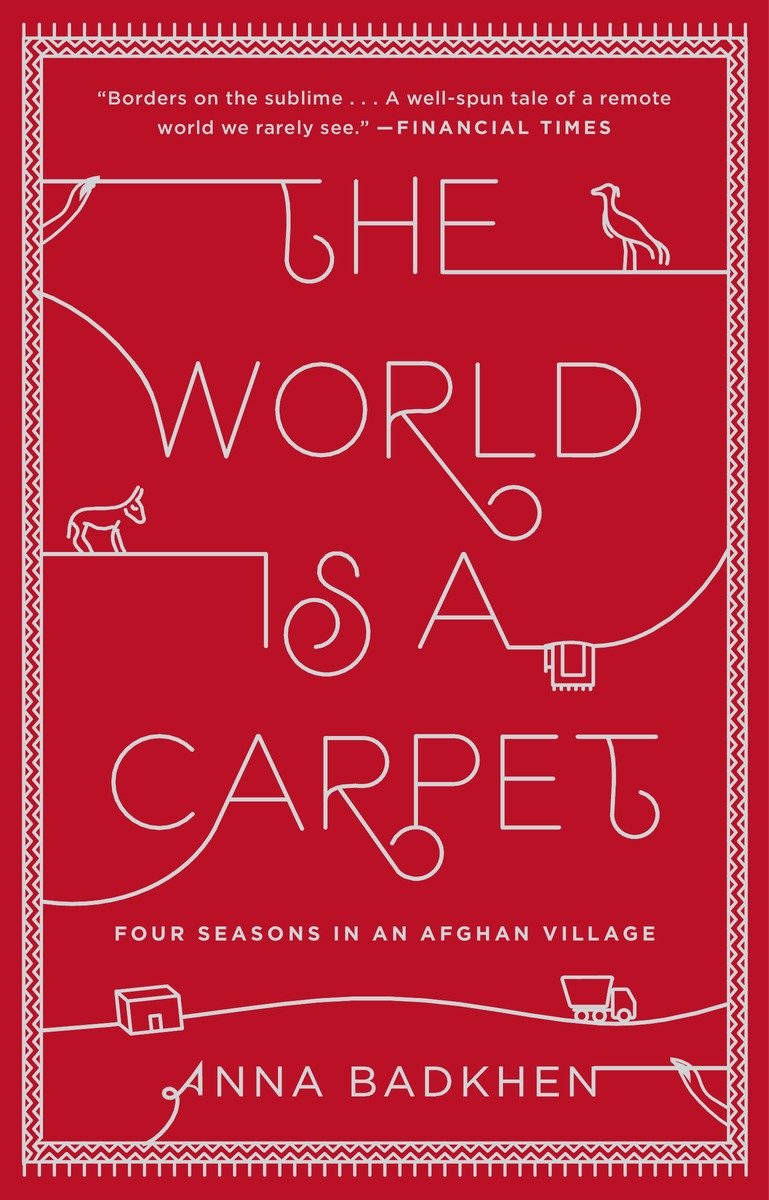The World Is a Carpet: Four Seasons in an Afghan Village
19.00 JOD
Please allow 2 – 5 weeks for delivery of this item
Description
An unforgettable portrait of a place and a people shaped by centuries of art, trade, and war.In the middle of the salt-frosted Afghan desert, in a village so remote that Google can’t find it, a woman squats on top of a loom, making flowers bloom in the thousand threads she knots by hand. Here, where heroin is cheaper than rice, every day is a fast day. B-52s pass overhead—a sign of America’s omnipotence or its vulnerability, the villagers are unsure. They know, though, that the earth is flat—like a carpet.Anna Badkhen first traveled to this country in 2001, as a war correspondent. She has returned many times since, drawn by a land that geography has made a perpetual battleground, and by a people who sustain an exquisite tradition there. Through the four seasons in which a new carpet is woven by the women and children of Oqa, she immortalizes their way of life much as the carpet does—from the petal half-finished where a hungry infant needs care to the interruptions when the women trade sex jokes or go fill in for wedding musicians scared away by the Taliban. As Badkhen follows the carpet out into the world beyond, she leaves the reader with an indelible portrait of fates woven by centuries of art, war, and an ancient trade that ultimately binds the invaded to the invader.
Additional information
| Weight | 0.26 kg |
|---|---|
| Dimensions | 1.88 × 13.97 × 20.83 cm |
| PubliCanadation City/Country | USA |
| by | |
| format | |
| Language | |
| Pages | 288 |
| publisher | |
| Year Published | 2014-6-3 |
| Imprint | |
| ISBN 10 | 1594632677 |
| About The Author | Anna Badkhen has won awards for her reporting from the Middle East, Central Asia, East Africa, and her native Russia and the Caucasus. Her writing has appeared in The New York Times, Foreign Policy, The New Republic, The Boston Globe, and other publications. The author of Peace Meals and other nonfiction books, she lives in Philadelphia. |
| Excerpt From Book | The CarpetAt four in the morning a phalanx of black silhouettes setout across the desert: three people and a donkey headedwest on a sinuous dustbowl trail. The yogurt bow of themoon had slipped behind the Earth an hour earlier, and the trailwound invisibly through thick predawn dark that arced toward thehorizon. All was still. To the south, the Big Dipper scooped out themountains I could just skylight against the spongy, star-bejeweledMarch night.Amanullah led the way. He skirted the spines of cousinia andthe diaphanous spheres of calligonum only he could pick out,hopped the cape hare burrows he alone knew about, sidestepped theboulders he alone remembered. He never changed pace. He neverbent down to check for sheep spoor. He never looked up: he didn’tnavigate by stars, didn’t know their names, didn’t recognize the constellations.What for? Stars were unreliable beacons, nomads thatmoved about the heavens at will, like the Turkoman forefathers.Have you never seen one suddenly tear off from its roost and streakacross the black, looking for a new home? Amanullah walked thetrail by heart, steering from a memory that wasn’t even his own buthad double-helixed down the bloodstream of generations of menwho had traveled this footpath perhaps for millennia. A memorythat was the very essence of peregrination, a flawless distillation ofour ancestral restlessness.We walked single file. Amanullah first, then the donkey, thenFahim, who taught English at an evening school in Mazar-e-Sharifand was helping me with translation, then I. At a brisk clip, in dryweather, the eighteen-mile walk across the hummocked loess usuallytook about five hours. Amanullah had made this journey everytwo weeks since he was six or seven. Now he was thirty.“If other people in the world walked as much as we do, andworked as hard as we do, they’d go crazy,” he announced. He pausedfor effect. Amanullah bragged about the unimaginable hardships oflife in the desert fondly and often. In the dark, I pictured him smilein sly satisfaction at the gravity of his own pronouncement. Butwhen he spoke again, he sounded surprised.“But we don’t.”It was Thursday, bazaar day in Northern Afghanistan. We werewalking to Dawlatabad, the market town nearest Oqa, Amanullah’svillage. We were going to Dawlatabad to buy carpet yarn forAmanullah’s wife, Thawra.For the next seven months, Thawra would squat on top of ahorizontal loom built with two rusty lengths of iron pipe, cinderblocks, and sticks in one of Oqa’s forty cob huts. Day after day, shewould knot coarse weft threads over warps of thin, undyed wool,weaving the most beautiful carpet I have ever seen.If the eastern hemisphere’s carpet-weaving region that extends fromChina to Morocco were itself a carpet, and one were to fold it in half,Thawra’s loom room would fall slightly to the right of the centerfold. Prehistoric artisans upon these plains were spinning wool andplaiting it into mats as early as seven thousand years ago. Sincethen, people here have been born on carpets, prayed on them, slepton them, draped their tombs with them. Alexander the Great, whomarched through the Khorasan in 327 bc, is said to have sent hismother, Olympias, a carpet as a souvenir from the defeated Balkh,the ancient feudal capital about twenty-five miles southwest of Oqa.For centuries, carpets were a preeminent regional export, a currency,status symbols, attachés. When Tamerlane, who was crowned emperorat Balkh, was absent from his court, visitors were permittedto kiss and pay homage to his carpet, which they were instructed totreat as his deputy.Of all the Afghan carpets, those woven by the Turkomans arethe most valued. Marco Polo, in the thirteenth century, laudedTurkoman weavers for producing “the best and handsomest carpetsin the world.” Six hundred years later, Francis Henry BennettSkrine, a retired commissioner of the Indian Civil Service, and theLondon linguist Sir Edward Denison Ross wrote that Turkomancarpets were “unrivalled in Asia for beauty and durability.” For theirrich palette of reds—mahogany, terracotta, liver, and the atrorubentof the fratricidal blood that soaks their land—the Turkomans arecalled the Rembrandts of weaving.Fine clay dust will filter into Thawra’s mud-and-dung loom room asshe weaves. Through the scrub-brush lath ceiling there will seepinto the room particles of manure, infi nitesimal flecks of gold fromnearby barchans, the terrible black cough of her neighbors’ famishedchildren, echoes of the war that jolts the plains and contorts theCretaceous massifs of her land. A roadside bomb will go off, and thedesert outside her doorless entryway will groan in response with thephantom footfalls of past invaders: Achaemenid and Greek, Mughaland Arab, Ottoman and Russian, British and Soviet. A speck of anAmerican Navy F/A-18 strike fighter will catch a sudden sunray onits wing and for the instant it pierces the incredibly high azure itwill become a ghost of a different glint: on Genghis Khan’s swordbefore it split the skull of a Bactrian housewife, on the barrel of aguerrilla’s jezail matchlock before it discharged at some subalternof the Raj. Taliban scouts will appear on the path where Amanullahand I walked for yarn, then vanish again, the way all raiderscome and vanish upon this eternal battleground.Thawra’s will be a yusufi carpet, a diamond pattern her motherand her mother’s mother wove before her, on the backdrop of warspast. Under her thin fingers, almond-size flowers with ogival petalswill shine in a field of ocher and deep maroon. Each fl ower willbloom from two hundred and forty knots she will tie by hand theway her foremothers did; each knot will be a temporal Möbius stripthat ties past and present.Once the carpet is finished it will take flight from this fantasticallybrutalized land that clings to the violent tectonics at thethirty-fourth parallel. Amanullah will roll it up and cram it intohis donkey saddlebag, and his father will take the familiar footpathacross the desert to deliver it to Dawlatabad. A middlemanthere will sell it to a dealer from Mazar-e-Sharif, the largest city inNorthern Afghanistan, the modern capital of Balkh. After that,perhaps, Thawra’s carpet will be jabbed into the back of a beat-uptaxicab, then tossed into the bed of a truck painted with dreamypastorals, in which it will journey across Afghanistan’s war-rackedlandscape and over the border, through Pakistan’s implacable tribalareas, to the rug markets of Peshawar and Islamabad. Or maybe itwill travel west, past the mass graves of Dasht-e-Leili, across theKarakum Desert, to the bazaars of Istanbul. Or else it will trundlein the trunk of a bus bound for Kabul, from where it will fl y toDubai, and from there, across the Atlantic Ocean until it alights ata dealership in the United States, the single largest purchaser ofcarpets on the world market at the time of this story. A wealthypatron will pay between five and twenty thousand dollars for it.Wherever her carpet ends up, for her work Thawra will be paid lessthan a dollar a day.But first, she will weave. After each knot, she will cut weft yarnfrom its ball with a small, sweat-darkened sickle. Thk, thk, thk, thesickle will go, measuring time between dawn and dusk, birth anddeath, peace and war, measuring life immemorial. |
Only logged in customers who have purchased this product may leave a review.






Reviews
There are no reviews yet.